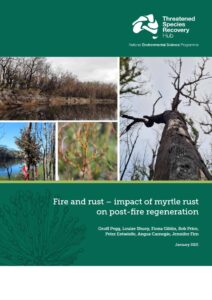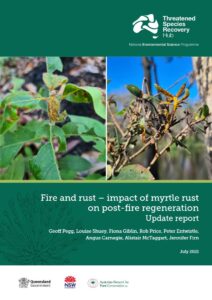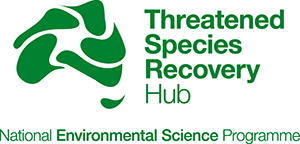Assessing the impact of Myrtle rust on fire regeneration
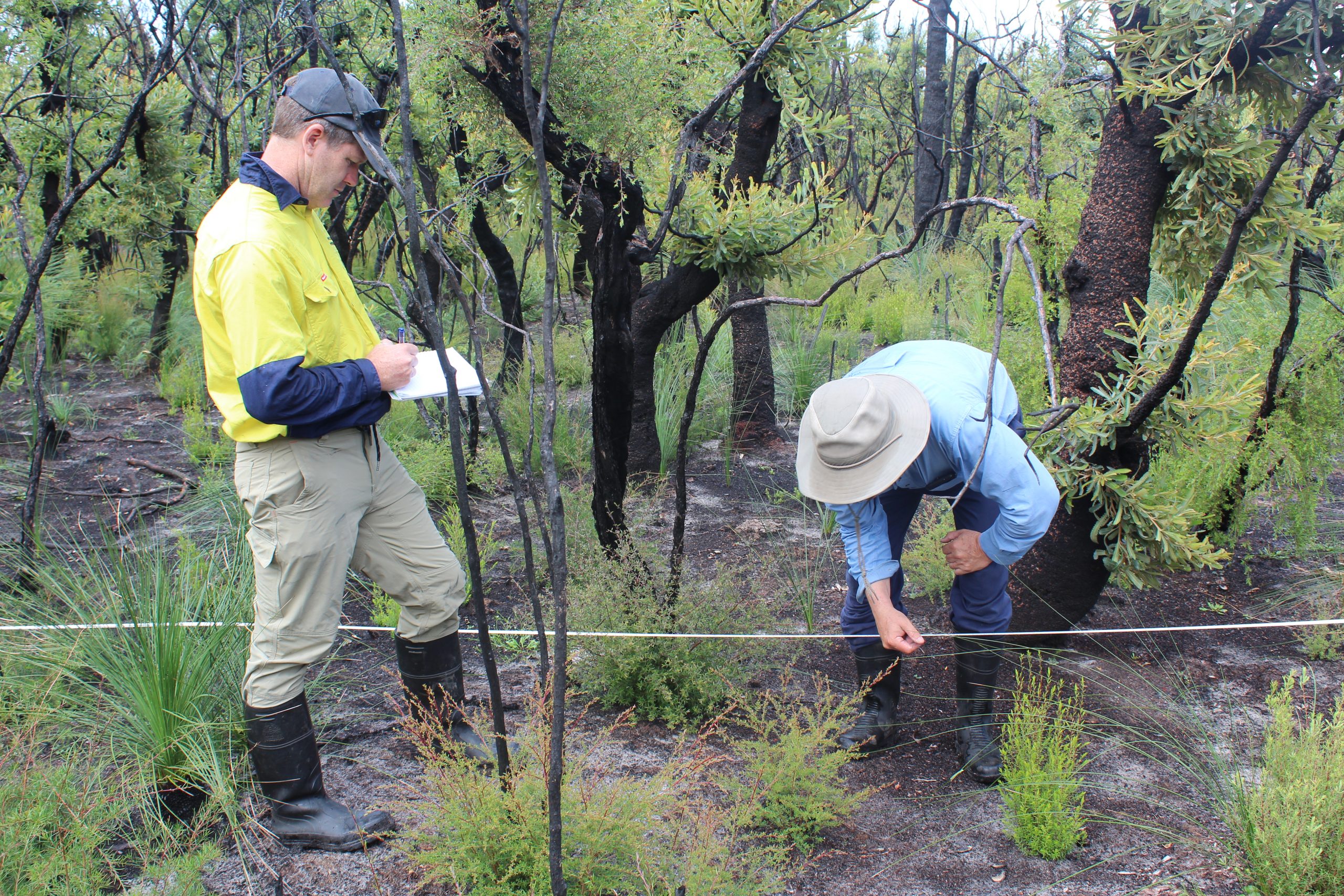 Major project outcomes
Major project outcomes
Extensive surveys assessing the impact of Myrtle rust (Austropuccinia psidii) were conducted following the 2019/20 wildfires. Myrtle rust symptoms and damage were found in all survey sites in fire-affected areas of south-east Queensland and NSW south to the Central coast region. This included coastal heath, woodland and swamp environments, littoral and notophyll vine forests along the coast, inland paper bark swamp ecosystems, inland eucalypt woodlands, wet sclerophyll and rainforest ecosystems as far west as the Great Dividing Range.
Surveys identified new host species for Australia including Leptospermum speciosum (Showy tea tree), Eucalyptus pyrocarpa (Large-fruited blackbutt) and Eucalyptus amplifolia subsp. amplifolia (Cabbage gum). Significant impacts were identified on Rhodamnia rubescens (Scrub turpentine), listed as Critically Endangered in NSW, with populations affected in all Gondwana World Heritage Areas assessed. The range of restricted and endangered Uromyrtus australis (Peach myrtle), confined to Nightcap National Park, was also identified as being impacted upon. .
New fire affected areas on K’gari (Fraser Island) were assessed and this is the first report of Myrtle rust symptoms on Eucalyptus pilularis (Blackbutt) and Syncarpia hillii (Satinay) on the World Heritage sand island. It is also the first report of Myrtle rust naturally infecting Syncarpia hillii seedlings and reshoots.
Regeneration of Melaleuca quinquenervia (Broad-leaved paperbark), particularly in New South Wales, is of concern. The loss of established trees, along with the fact that only 15 to 35% of the seedlings are showing evidence of resistance, raises questions over regeneration of the species at these sites. Longer-term monitoring is required to determine the consequences of:
1. The death of established trees and decline rates in relation to Myrtle rust infection levels.
2. The impact of disease on seedling recruitment levels and the recovery of the species within sites.
3. The impact on flowering and seed production over time.
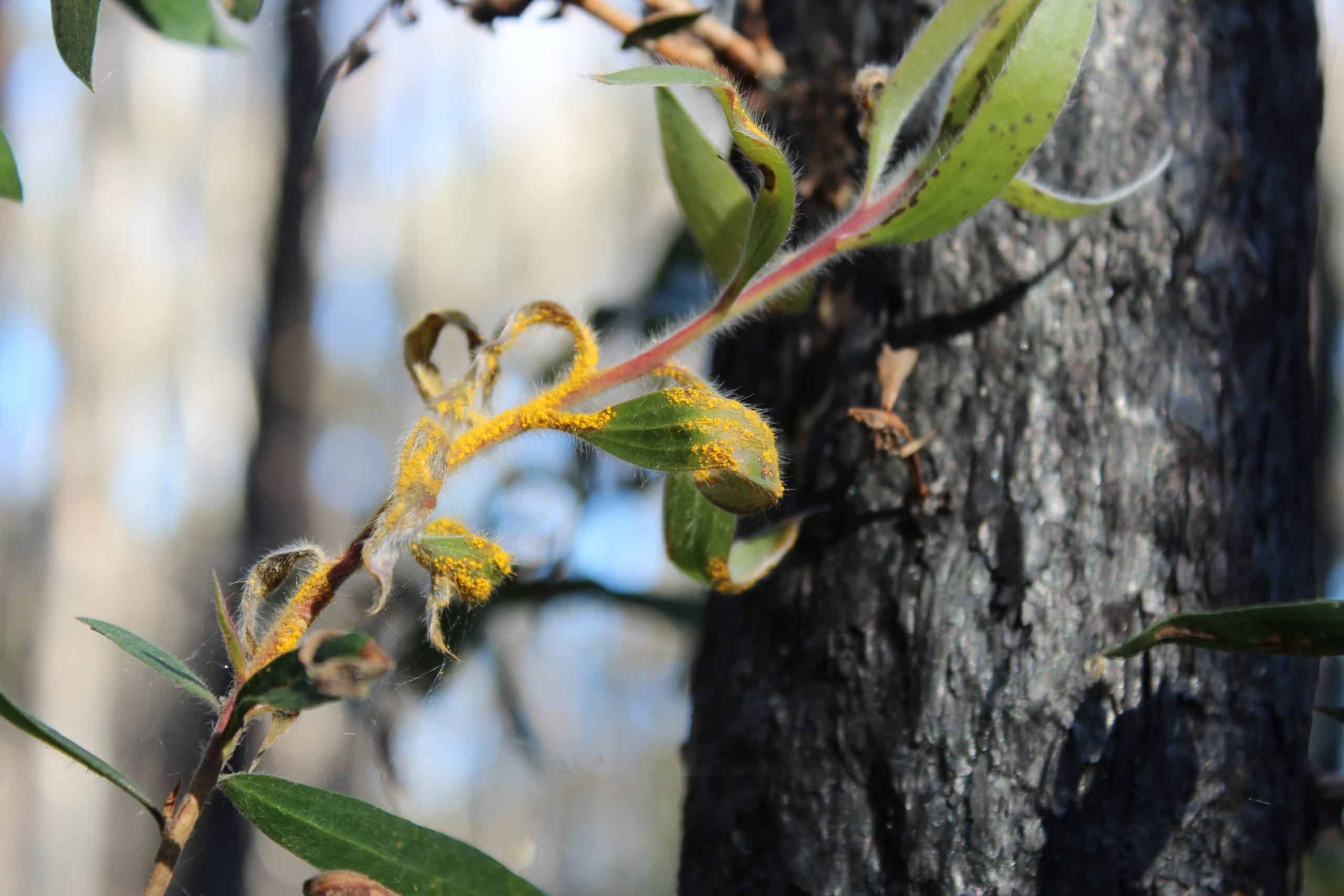 Melaleuca nodosa (Prickly-leaved paperbark) is highly susceptible to Myrtle rust with only small numbers of trees showing resistance/tolerance to the disease, which also appears to directly impact flowering. Dieback because of repeated Myrtle rust infection is reducing plant vigour and the ability to compete for space with non-Myrtaceae and other less susceptible Myrtaceae.
Melaleuca nodosa (Prickly-leaved paperbark) is highly susceptible to Myrtle rust with only small numbers of trees showing resistance/tolerance to the disease, which also appears to directly impact flowering. Dieback because of repeated Myrtle rust infection is reducing plant vigour and the ability to compete for space with non-Myrtaceae and other less susceptible Myrtaceae.
While one-off surveys of sites can provide information on species susceptibility, longer term monitoring is required to understand impacts of Myrtle rust on Myrtaceae regenerating after wildfire. This includes:
• Long-term survival of species and/or individuals.
• Recovery of species and/or changes in population levels.
• Impacts on fecundity and long-term recruitment.
The following manuscripts will be prepared for publication at the completion of assessments:
• Host range and impact of Myrtle rust on fire affected Myrtaceae in different ecosystems on K’gari.
• Impact of Myrtle rust on Myrtaceae in fire affected rainforests of south-east Queensland and north-east New South Wales.
• Impact of Myrtle rust on recovery of fire affected Myrtaceae in coastal heath and woodland environments in New South Wales and south-east Queensland.
Background
While fire is considered an important selection agent in the development of Australia’s native flora, the development of new epicormic regrowth and young seedlings en-masse after fire are ideal for the development and spread of the rust fungus Myrtle rust (Austropuccinia psidii). Recent extreme fire events have resulted in significant impacts on a range of different ecosystems, with widespread epicormic and seedling regeneration now occurring, creating ideal conditions for the spread and impact of rust.
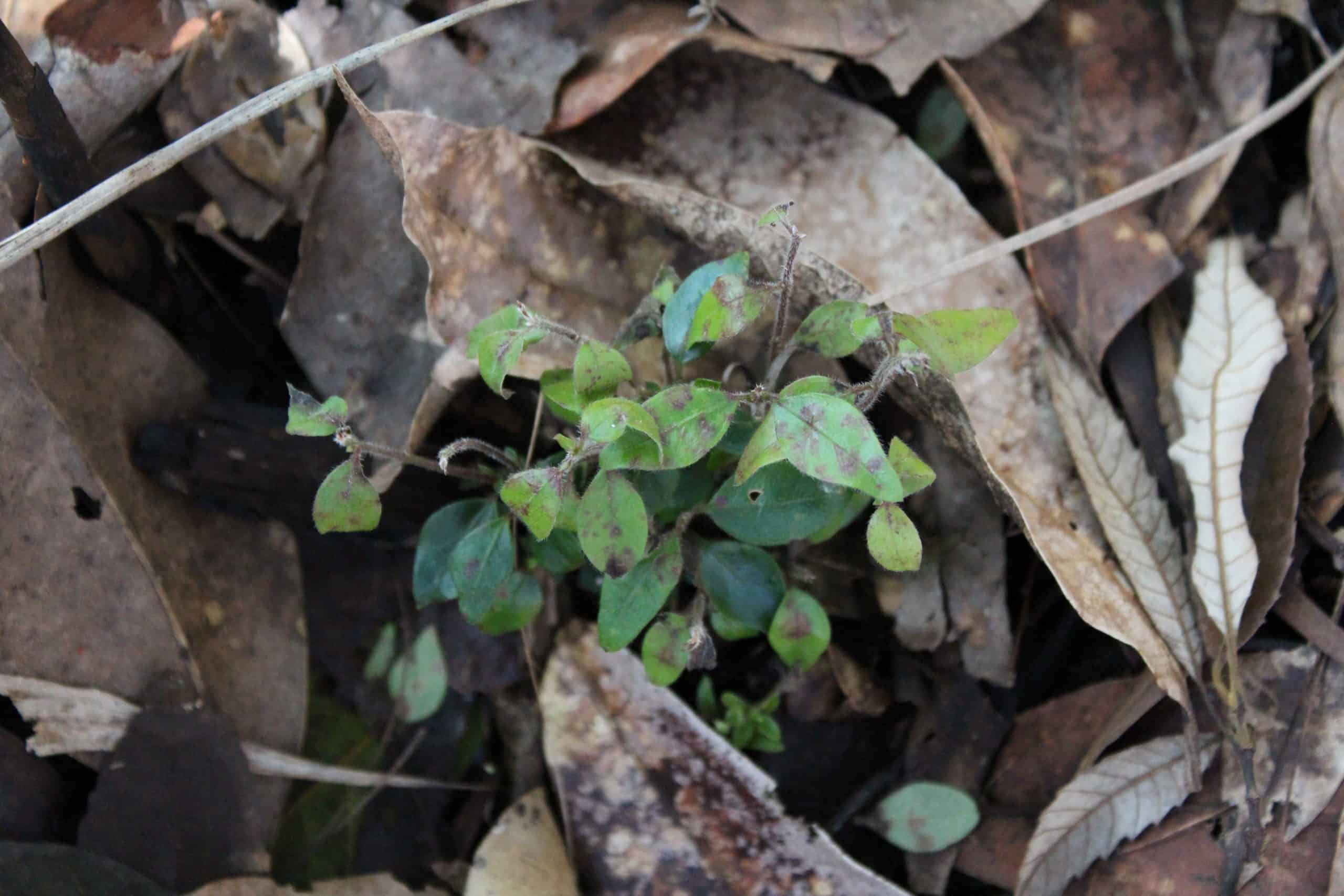 Project Aims
Project Aims
This project, funded by the Threatened Species Recovery Hub, aimed to determine the susceptibility and impact of myrtle rust on Myrtaceae species regenerating after the 2019-20 wildfires. Locations across fire affected regions in NSW and Queensland were targeted with general surveys to capture data across a range of sites and species. Short term impact assessment plots were established at selected sites and data recorded on disease progression/species decline rates on a monthly basis. The project identified the species showing susceptibility and the regeneration forms (re-shoots/seedlings) affected by Myrtle rust. The effect of repeated infection on species recovery/survival was determined for species highlighted in priority lists, including bushfire affected threatened plants.
In cooperation with the Department of Agriculture & Fisheries Queensland, the NSW Department of Primary Industries, the University of New South Wales, Queensland University of Technology, and technicians and botanists drawn from the private sector, surveys were conducted across a wide range of ecosystems to capture information on species susceptibility. Surveys were conducted over nine months in 2020/21 during the peak periods for Myrtle rust activity. Data was collected on a range of species of known susceptibility and locations where Myrtle rust is likely to be most damaging. Monitoring plots were established or recommended based on survey results, focusing on species identified as likely to be at higher risk, to assess the impact of repeated infection of Myrtle rust on post-fire plant regeneration. Preliminary surveys suggested species not normally seen as susceptible in undisturbed sites were becoming infected and impacted by Myrtle rust.
The research took place across a number of sites and ecological communities in Queensland and New South Wales:
- reserves within the Gondwana Rainforests of Australia World Heritage property (Lamington and Main Range National Park, Washpool and Gibraltar National Park)
- sites in both states featuring the Lowland Rainforest of Subtropical Australia Threatened Ecological Community
- coastal heath and woodland environments in New South Wales and Queensland (Bundjalung and Cooloola/Noosa National Parks/K’gari (Fraser Island))
- environments on the south coast of New South Wales affected by fire.
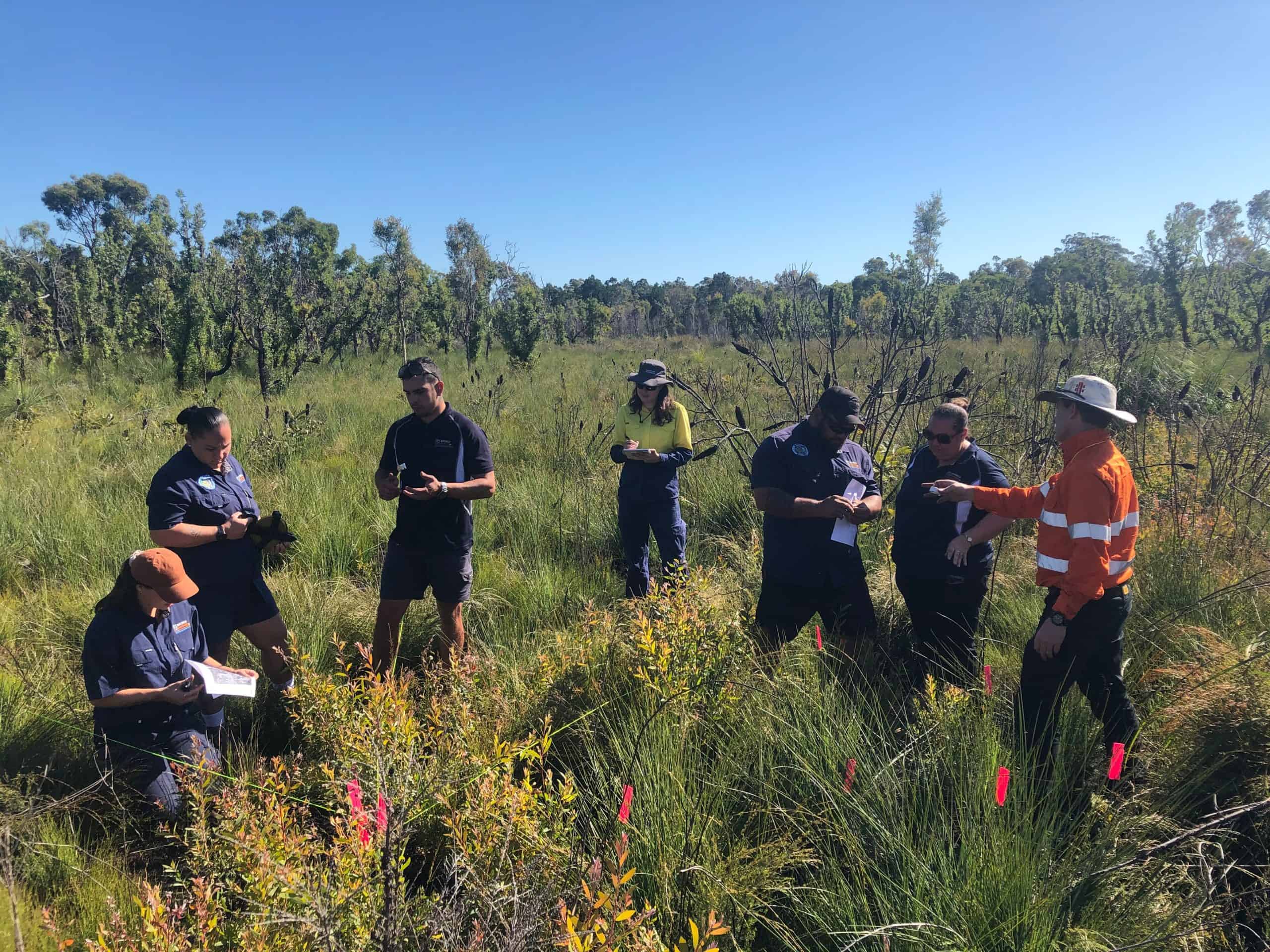 During the surveys, impacts on reshoots and seedlings of a range of species were recorded. Additional site data collected included fire severity, vegetation type and species composition. Where possible, species present across different environments were targeted (e.g., Melaleuca nodosa, M. quinquenervia, Eucalyptus pilularis). Disease incidence and severity data was collected for a range of species and locations where rust is likely to be most damaging. To assist with species conservation and/or restoration planning, data on species populations and/or individuals free of disease and possibly resistant to myrtle rust was also captured.
During the surveys, impacts on reshoots and seedlings of a range of species were recorded. Additional site data collected included fire severity, vegetation type and species composition. Where possible, species present across different environments were targeted (e.g., Melaleuca nodosa, M. quinquenervia, Eucalyptus pilularis). Disease incidence and severity data was collected for a range of species and locations where rust is likely to be most damaging. To assist with species conservation and/or restoration planning, data on species populations and/or individuals free of disease and possibly resistant to myrtle rust was also captured.
In-field Myrtle rust identification and assessment training workshops were also provided to regional Parks and Wildlife staff, landowners and land care groups, to assist in expanding the capacity to report on Myrtle rust impacts.
The ANPC would like to thank the Threatened Species Recovery Hub for this funding.
All photos on this page provided by Geoff Pegg.

